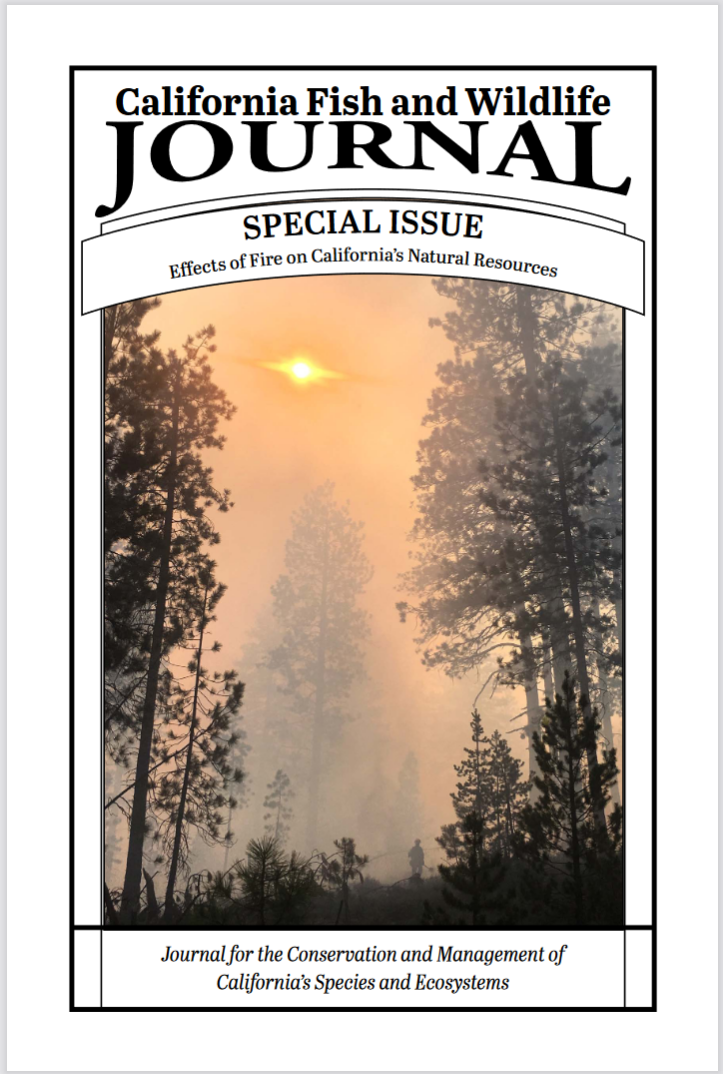 The California Fish and Wildlife Journal concludes the 2020 Special Issue installments with the winter quarter’s Special Wildland Fire Issue. With this year’s unprecedented fire season, and California’s fire-adapted natural communities taking center stage in land management discussions throughout the State and beyond, this issue is especially poignant as we reflect on this past year and contemplate the incoming new year.
The California Fish and Wildlife Journal concludes the 2020 Special Issue installments with the winter quarter’s Special Wildland Fire Issue. With this year’s unprecedented fire season, and California’s fire-adapted natural communities taking center stage in land management discussions throughout the State and beyond, this issue is especially poignant as we reflect on this past year and contemplate the incoming new year.
Unlike previous Special Issues, this issue is divided into three sections: Vegetation Treatment and Policy, Fire Impacts on Plants, and Fire Impacts on Wildlife and Water. Each section highlights a piece of the wildfire and landscape management ‘puzzle’ through an examination of fire and its impacts on California’s fire-adapted ecological landscape.
One of these unique communities, the Pine Hill Ecological Reserve in El Dorado County, is home to almost 750 plant species, some of which can only be found at Pine Hill due to its unique soil composition. Researchers from CDFW, the California Native Plant Society and Sacramento City College investigate the impacts of different fuel-reduction methods on Pine Hill Ceanothus in “Effects of a firebreak on plants and wildlife at Pine Hill, a biodiversity hotspot, El Dorado County, California” (PDF). The article examines the effects of hand clearing and pile burning on chaparral species within the Wildland Urban Interface and the secondary impacts on wildlife. The study also includes the exciting discovery of new seedlings of Pine Hill Flannelbush, the rarest and most endangered plant in El Dorado county, and a fire-obligate germinator!
Plants that depend on fire to propagate aren’t the only plant communities impacted by the long-term fire suppression practiced in the western United States. New and updated technology is helping landscape managers and scientists study and assess the pre- and post-fire impacts to landscapes using remote sensing and modeling techniques. This type of data collection and analysis helps inform scientists and policy makers on landscape and watershed-level scales and helps focus efforts to manage habitats and sensitive plant communities before and after wildfires. One such effort is presented by Sonoma County scientists in ![]() “Sonoma County Complex Fires of 2017: Remote sensing data and modeling to support ecosystem and community resiliency” (PDF). With the help of NASA and other experts the team evaluates the impacts of the 2017 fires to woody vegetation within areas that burned during wind-driven and non-wind driven events to evaluate canopy condition. Using lidar data, the team identifies important predictors for post-fire woody canopy condition, which highlights the importance of high-resolution airborne mapping technology for informing management decisions.
“Sonoma County Complex Fires of 2017: Remote sensing data and modeling to support ecosystem and community resiliency” (PDF). With the help of NASA and other experts the team evaluates the impacts of the 2017 fires to woody vegetation within areas that burned during wind-driven and non-wind driven events to evaluate canopy condition. Using lidar data, the team identifies important predictors for post-fire woody canopy condition, which highlights the importance of high-resolution airborne mapping technology for informing management decisions.
Management decisions include when and how to monitor pre- and post-fire events, and the CSU Monterey Bay’s study ![]() “Analysis of the impacts of the Soberanes Wildlife on stream ecosystems” (PDF) highlights the need for monitoring wildfire’s impacts on coastal streams and benthic macroinvertebrate responses to fire events. This monitoring is especially important because macroinvertebrates are the foundation for in-stream salmon and steelhead foodwebs, and the ability of these microscopic organisms to recover from wildfire also impacts the recovery of these keystone species in California’s rivers and streams.
“Analysis of the impacts of the Soberanes Wildlife on stream ecosystems” (PDF) highlights the need for monitoring wildfire’s impacts on coastal streams and benthic macroinvertebrate responses to fire events. This monitoring is especially important because macroinvertebrates are the foundation for in-stream salmon and steelhead foodwebs, and the ability of these microscopic organisms to recover from wildfire also impacts the recovery of these keystone species in California’s rivers and streams.
This quarter’s Special Wildlife Fire Issue also includes examinations of impacts and responses of Roosevelt Elk forage in Humboldt County, an essay on the California Vegetation Treatment Program, amphibian responses to wildfire and other topics that span California’s rich ecological diversity.
The California Fish and Wildlife scientific journal has published high-quality, peer-reviewed science that contributes to the understanding and conservation of California’s wildlife for more than 100 years. We look forward to the continued contributions in the next decade to come.



